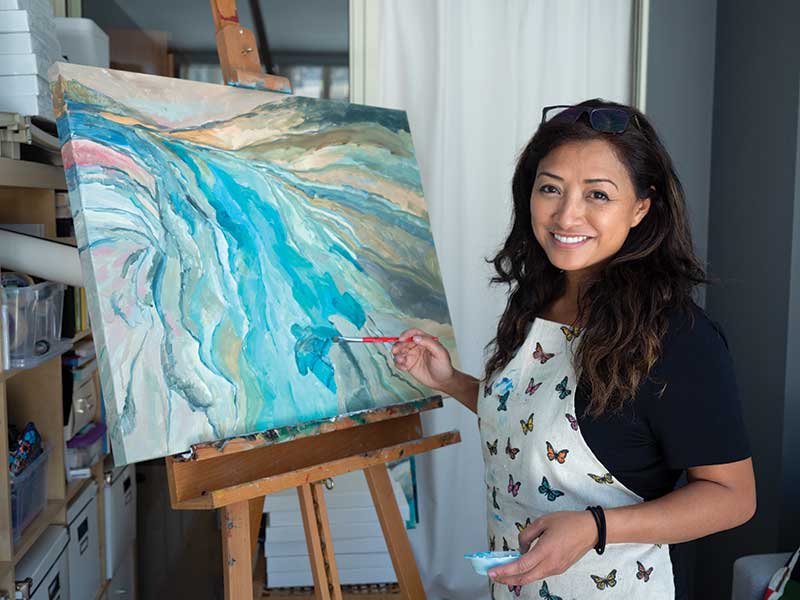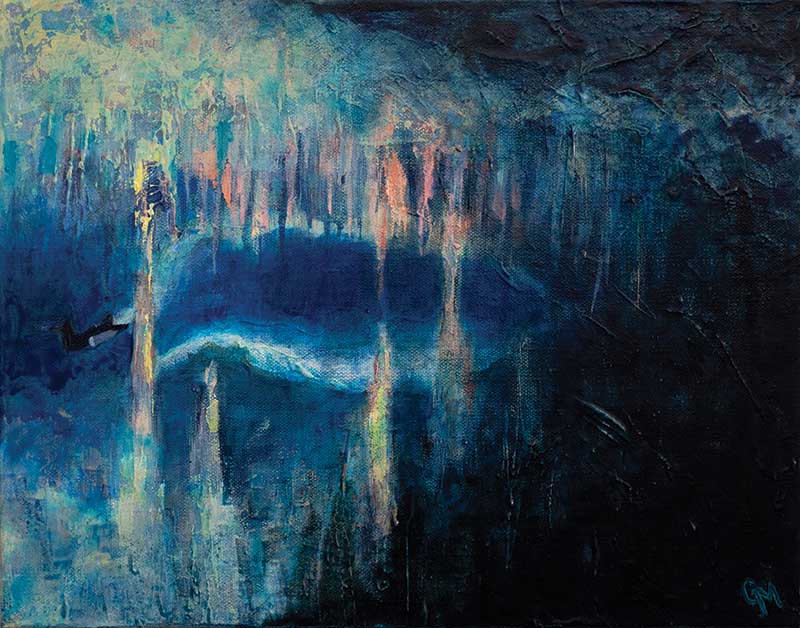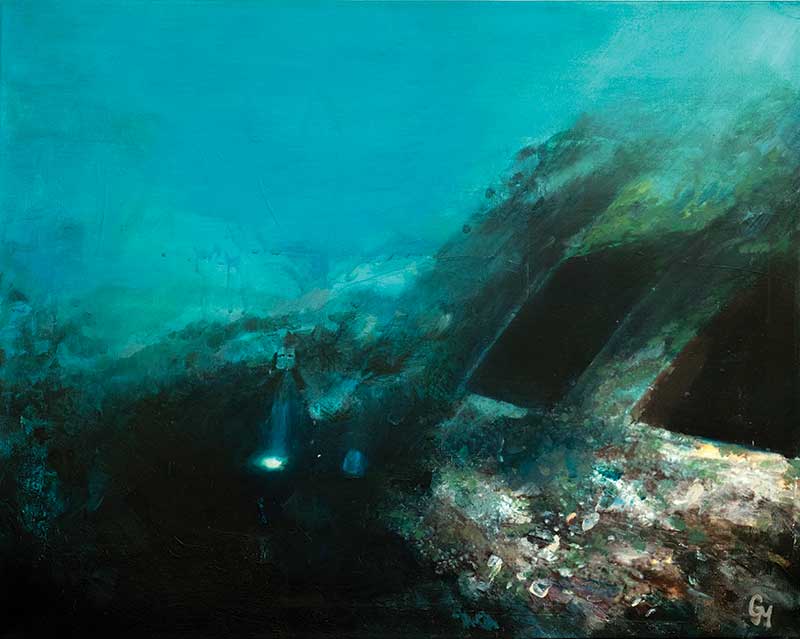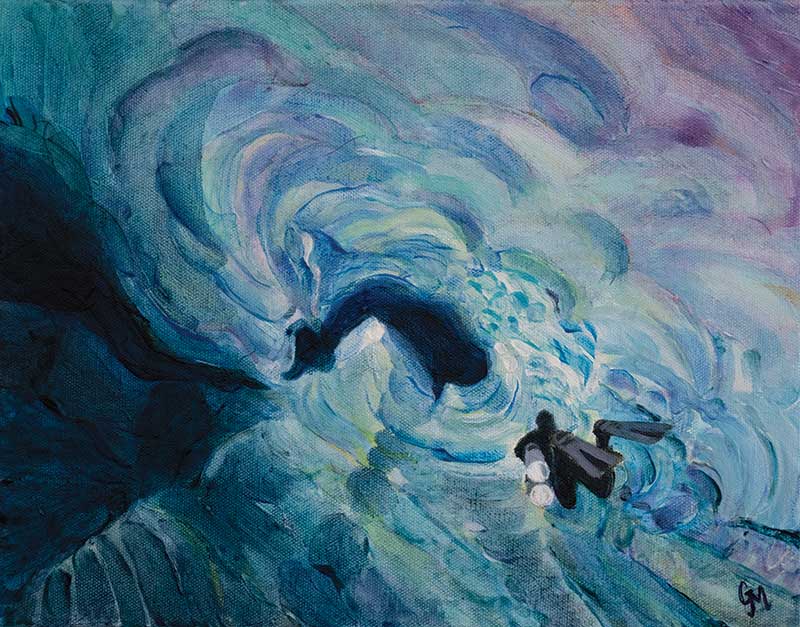Waterlust of a Canadian Artist
Canadian Artist Grace Marquez captures the essence of what it is to be submerged
Words by Robert Osborne

Diving can be a very personal, almost intimate experience. Perhaps it’s the silence—the lack of chatter—that surrounds the activity; perhaps it’s because it’s such an all absorbing activity—no clutter from daily life. Regardless of the why, diving borders on being somewhat of a sacred activity for me and I think many others. That’s why, for the most part, I’ve never been very impressed with much of the art that tries to represent the underwater world and experience. It doesn’t seem to capture the spirit. Now there are many great photographers who capture beautiful images, but in particular, I’ve not really been impressed with what’s done in other mediums: I find them to be often bordering on what could be described as cheesy.
That changed a few months ago. I stumbled across a Facebook posting. It was a painting of a diver moving through an underwater cave. The work was both an explosion of colour and energy yet with patches of darkness that evoked untold mystery. I’d never seen dive-related paintings like this before. Though not in any way ‘photo realistic’, the painting came close to capturing the experiences I had when I was cave diving—a magical world, but one with a slightly ominous overtone. This artist understood that experience. I decided I wanted to know a great deal more.

In fact, it turned out I knew the artist—or rather I knew the diver. I knew her name was Grace Marquez and she was part of the community of technical divers based in Toronto. Through a few degrees of separation, we had a lot of people we knew in common and with whom we had dived. But I had no idea that Grace was such a talented painter. In fact, I had no idea she painted at all.
I soon learned that Grace was born in the Philippines, grew up in Toronto and went to school at Queens University in Kingston, where she studied Fine Arts. After graduation she says she faced the same dilemma many arts students face: what to do for a living. She went back to school to Sheraton College and studied computer graphics. Since graduating, she’d built a successful career in digital marketing. But it turned out that while she redirected her creative drive to accommodate her work, that didn’t mean she’d abandoned her love of painting. It did, however, take an odd twist in her life, to motivate her to pick up her brushes and palette knives once again.
That ‘twist’ began in 2009 when Grace went on a trip with her family to Palawan in the Philippines. Water sports were included in the package they’d paid for at a resort. Grace decided to try the Discover Scuba program. She says right from the start she was blown away by the underwater world. She says the reef off the resort was spectacular and that finding a ‘Nemo fish’ in an anemone made her feel like she was diving in an aquarium. “As soon as I came back to Canada, I signed up with Oakville divers and got certified.” But Grace admitted that at this point, diving was only an occasional activity, when she was down south in warm water. Nonetheless, the diving hook was in. Grace realized that diving was the “only place where I am one hundred percent present with my mind, body and spirit.” It offered her a kind of peace and tranquility that was rare in her busy life.
Grace didn’t bother to do her advanced training for several years: “Wasn’t until I met the late Carlos Fonseca at Dan’s Dive shop that I started to see some possibilities for a different kind of diving—diving in colder water and diving using more refined skills.” Carlos convinced her that the world she loved down south was readily available within a few hours’ drive of where she lived. So, she donned a 7 mm wet suit and did her advanced training in Tobermory. “It was a turning point in both my diving and artistic pursuits. My thoughts on art and the underwater world began to change. When I moved into technical diving, I started to spend more time on the bottom. I was able to spend the time to really look around. I started to take video of my dives and really examine the footage that I had gathered…I wanted to share what was down there.” To do that, Grace began to paint again. She began to try to capture what she was feeling when she was submerged, “I have these moments—mostly on wrecks or in caves—where I’m blown away by what nature has done to create these experiences.”

The essence
Grace made some interesting choices in working towards her goal of capturing the essence of what she experiences underwater. The first one was that she was not going to create ‘realistic’ paintings. Quite the contrary, she wanted to avoid photorealism. “I try hard not to make my paintings photo real. I want to show the mystery of what I’m seeing, more expressionistic, I want to capture the essence of that place and time.” Harkening back to earlier impressionists and expressionist painters, Grace wanted to capture the play of light on the surfaces of the underwater world; to create a sense of reality in motion in time. “The world is never in perfect focus,” Grace adds, “It’s always in motion, with light playing across the surface.” To accomplish that sense of light and time, Grace decided to work mostly with acrylics and layers of glazes—all of which create an almost dreamlike feel to her work. “I like to work a lot with a pallet knife. I don’t want the images to take on the look of a realistic photo. When I find that’s what’s happening, I put down my brushes and pick up a palette knife again.”
That’s what makes Grace’s work resonate with me. It’s not just what’s there on the canvas, but also what’s not there. Grace fills her canvases with dark corners that leave the viewer wondering about what they could be seeing that may be just out of the reach of the light. As Grace says, “The darkness is important, there’s beauty in that.”
One particularly stunning piece I love shows the stern of the wreck of the Arabia in Tobermory, Ontario. While the bow of that ship, which sank in the late 1800s, is in pretty good shape, the stern is a jumbled mass of planks criss-crossing each other. I’ve dived that wreck more times than I can remember but I’d never seen much beauty in those planks. But Grace saw something. She turned that wreckage into a what appears to be a display of bold shafts of blue and green light, almost reminiscent of a work by Lawren Harris. Only after I looked at the painting several times did I notice a diver in the painting slowly emerging from the shadows.
Aside from wrecks, her favourite topic is caves. What’s really impressive is that she turns that pitch-black world into a magical kind of landscape that, ironically, resonates with colour. Grace says that in caves, “When you have your lights on, all the colour comes to life, the sparkle of the minerals…I try to capture that.” A painting she calls ‘At the Next Turn’ is a wonderful example: a dark tunnel recedes into the distance with a faint light showing in one corner. The rich world captured in purples, greens, and blacks hints at an undiscovered adventure lying just around the corner. Not a world of darkness and fear but rather one of adventure full of promise.

Waterlust
Clearly Grace’s work resonates with people other than me. When I interviewed her for this article, she was working towards her first exhibition. She explained that the whole event came about much by happenstance. “I started working at a studio a few years ago. It gives me open studio time, a place where I can just go and paint. One of the artists, Milena Doncheva, saw my work and encouraged me to try to put on a show.” Though reluctant at first, Grace eventually decided to go for it so, “I found a gallery and submitted an idea for a show to them. They accepted my proposal and booked me for several days.”
When this article was first publishing Grace’s show, called Waterlust, had just ended, by all accounts a great success, hopefully the first of many. Her works represent an experience that is definitely worth seeing—even if you’re not a diver.
Check out more of Grace’s work at: www.gracemarquezstudio.com







